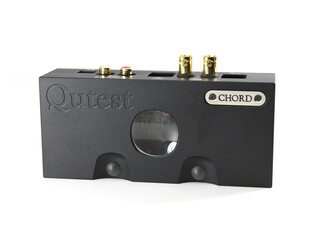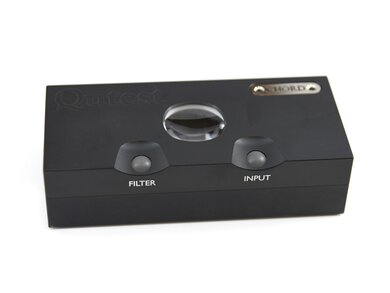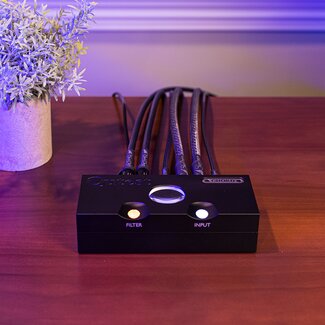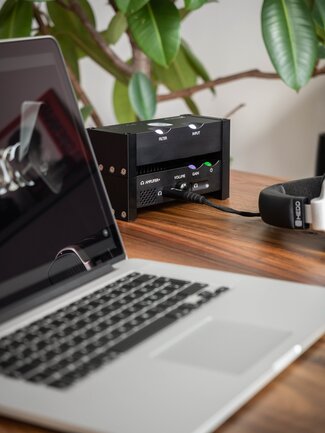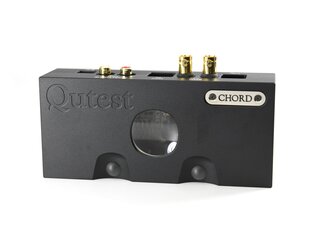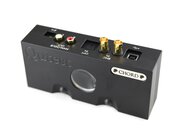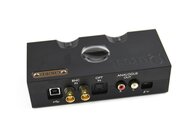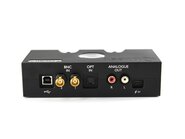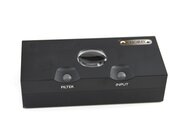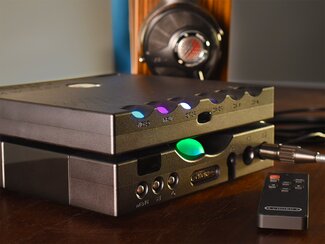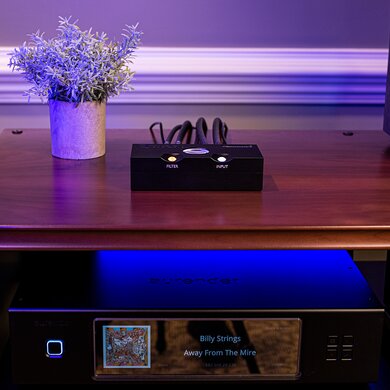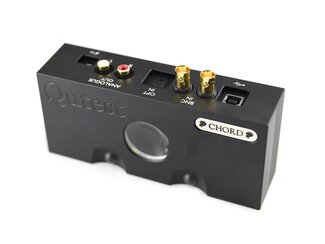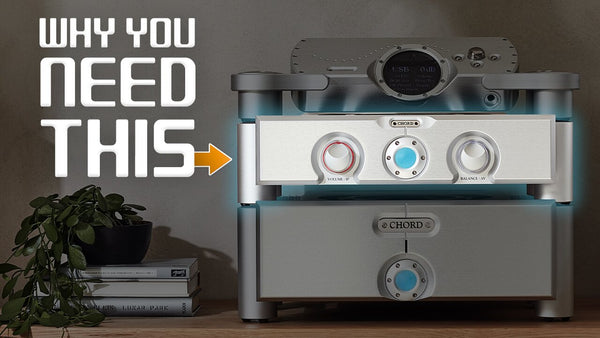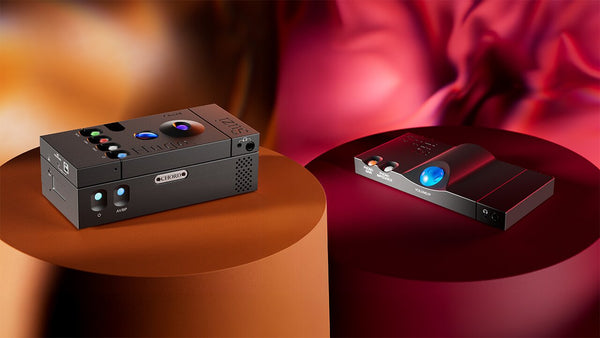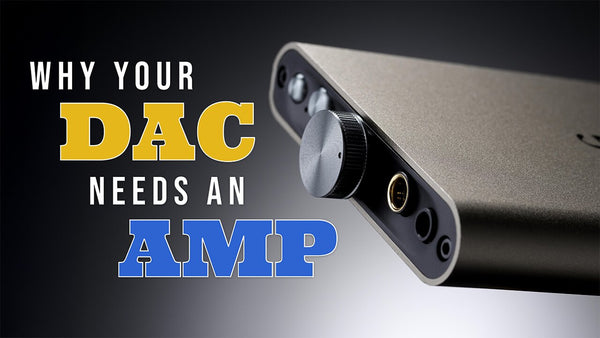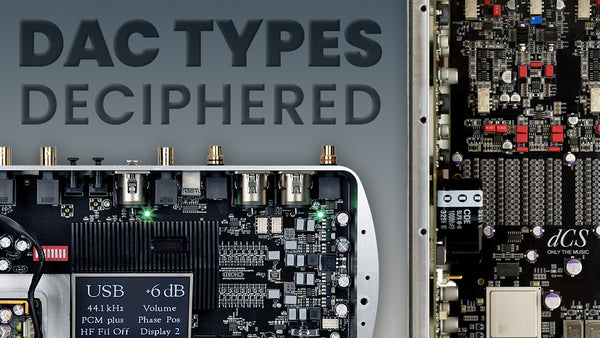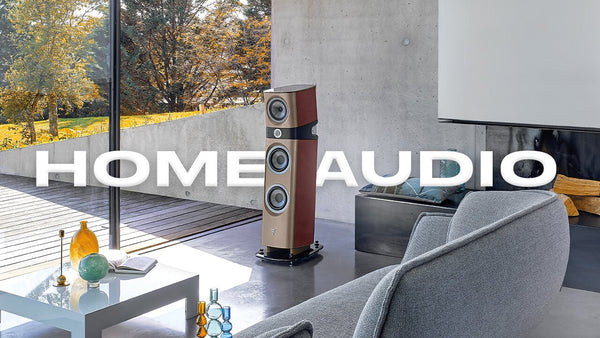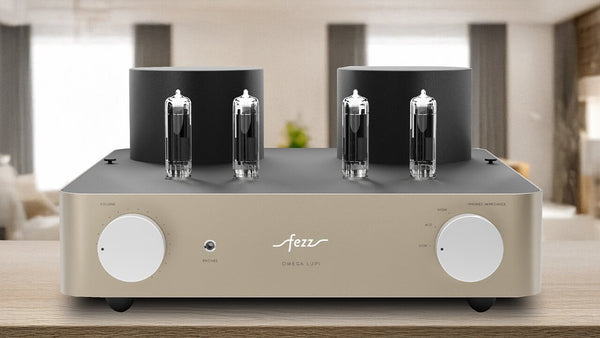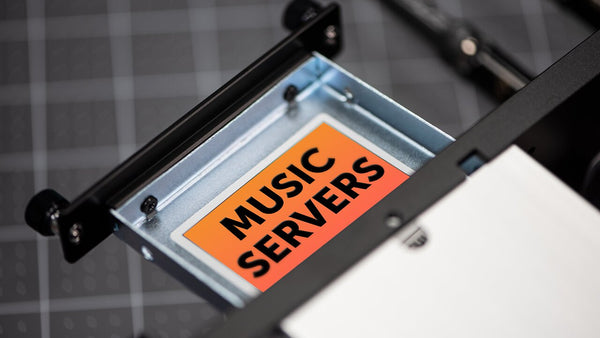Chord Qutest DAC Review: Audiophile's Delight
Read Time: Approx. 12 min.

TL;DR
- Upgraded DAC based on the Hugo 2 architecture, offering superior sound quality with doubled processing power, exceptional clarity, and a "dead quiet" background
- Versatile connectivity (USB, optical, dual BNC inputs), four selectable filters for sound customization, and adjustable output voltage 1V, 2V, 3V)
- Can be stacked with Chord's Anni amplifier and Huey Phono Stage and paired with an M Scaler for "endgame sound" quality
Aren't You The Qutest?
Chord Electronics' new products never disappoint. Their most recent digital-to-analog converter (DAC), the Chord Qutest is a giant killer. Essentially the DAC section of the Hugo 2 was placed in an aluminum brick, literally an aluminum brick, Chord removed Bluetooth input, the headphone amp circuit, and the battery. Removing those features was similar to the original Hugo.
The Qutest pictures don't do it justice. Chord crafted a mass of aluminum by boring out the center to fit its latest digital-to-analog converter's components. The latest sound innovation from England's Chord Electronics has a wonderful weight to it, much beefier than the 2Qute. Many improvements have been made. Chord doubled almost every good feature from the excellent 2Qute to create a new standard in DAC sound, design, and performance.
Chord Qutest DAC | Need To Know
Chord Qutest DAC Review
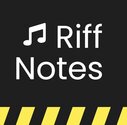
PROS
- Superb Chord sound based off Hugo 2 architecture
- Great I/O, Filters
- Pairs well with Anni and Huey--Stackable stand system
- Adding M Scaler makes for endgame sound
CONS
- Pricey
- You either love or hate the spherical controls
Design
As with all Chord products that come across our path here at Moon Audio, the overall construction and quality are hard to beat. Chord crafted a mass of aluminum by boring out the center to fit its latest digital-to-analog converter's components. It's a simple design, but effective. The weight is wonderful, and matched the form factor along with Chord's Huey phono stage and Anni headphone amplifier to create what we like to call the "Stack Pack." Yes, Chord has even developed a stand system that you can use with all three to save space on your desk or shelf and stack them one on top of the other. Chord does something similar with the Hugo TT 2, TToby, and M Scaler, or the DAVE DAC and the Etude amplifier. Chord's product lines have similar designs and form factors so that they can be stacked for a nice aesthetic and space-saving display.
Yes, the spherical controls return with a filter select and an input select button. The downside to Chord's use of colored controls is that whereas it might look aesthetically pleasing and minimalist, the color coding might take some time to remember and you'll find yourself referencing the manual or quick start guide often during your first few weeks of use. You'll find 4 filter options on the Qutest:
- Incisive Neutral (White): Designed for all who wish to hear the full spectrum of audio no matter what sample rate. This option has an ultra-linear frequency response. For the technically minded this includes a 16FS to 256FS WTA2 filter.
- Warm (Orange): Designed to introduce a little warmth to recordings, this filter will satisfy. This is a 16FS WTA1 filter only.
- Incisive Neutral HF Roll-Off (Green): Designed for purists in mind, who playback high sample rate PCM recordings, this option has an ultra-linear frequency response with a high-frequency filter past 20kHz to remove HF distortion and noise from these recordings. This includes a 16FS to 256FS WTA2 filter with the HF filter enabled.
- Warm HF Roll-Off (Red): Designed to introduce a little warmth to recordings, this filter will satisfy and is ideal for high-resolution PCM playback. This is a 16FS filter but with a high-frequency roll-off.
You'll find the input select button to correspond to the input options at the back of the unit. With four selectable digital input options, the Qutest acts as a digital hub:
- HD Type-B USB (White): Up to 768kHz and DSD 512 native playback, DSD 64 - DSD 256 via DoP, native DSD via ASIO.
- Coax 1 (Yellow): Up to 384kHz and up to DSD 128 (via DoP), Dual-data capable.
- Coax 2 (Red): Up to 384kHz and u to DSD 128 (via DoP), Dual-data capable.
- Optical Input (Green): Up to 192kHz and DSD 64 (via DoP).
The Qutest also has a variable output option, allowing you to select between a 3V (Blue), 2V (Green), and a 1V (Red) output, when you dual press the Filter and Input buttons on startup.
Improvement in the Qutest DAC processing power via the FPGA high-frequency digital-to-analog circuit with double the filter tap count may be Chord's most important performance improvement. For the sake of time, we won't dive into explaining "Tap counts." Let's simply say Chord doubled the Qutest's processing power. Watch our video overview/review below for more information.
Qutest Connections
Sound
It's hard to argue with the sound quality of anything from Chord Electronics, let alone something that is modeled after the Hugo 2. Chord products in general have some of the best detailing and clarity in the business, and the Qutest is no different. It's based on the proprietary FPGS technology developed for the Hugo 2 and contains 49,152 taps for those interested.
Quiet is what I noticed comparing the Qutest DAC to Chord's 2Qute. Chord's latest DAC makes your music's background dead quiet. No way was the 2Qute "noisy", but something about Chord's latest DAC makes the sonic background sound drop off a cliff and disappear.
Chord's Qutest DAC sound offers more resolution, detail, and clarity without becoming analytical or sharp. Tap count increases from 26k to almost fifty, so almost double the 2Qute DAC's resolution capability.
Much like the 2Qute, we don't recommend spending money on an external linear power supply. We found no improvements with the 2Qute and since the Qutest now uses a USB Micro B style input for power we don't see many options available for improvements from adding external linear power. We do recommend using Chord's supplied "wall wart" which needs 5v and at least 2.1amps. Moon Audio sells extra USB Power supplies if you need a second for another location.
2Qute vs. Qutest Features
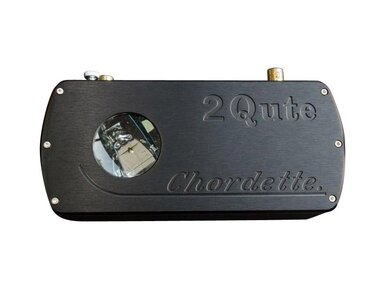
2Qute Features
- PCM support for up to 32-bit/384kHz audio via coax and USB
- Optical support at 24-bit/192kHz
- DSD64 is supported on all inputs
- DSD128 is supported via coax or USB (all via DoP).
Qutest DAC Features
- PCM support for up to 32-bit/768kHz audio via coax and USB
- Optical support at 24-bit/192kHz
- DSD64 is supported on the optical input
- DSD128 is supported by a single coax digital input
- DSD384 is supported by a Dual Coax digital input. This process is available from M-Scaler capable devices from Chord such as the Blu Player. I would imagine seeing more of these devices in the future from Chord.
The USB input supports 768kHz PCM and DSD up to 256 via DoP (Mac) and native DSD up to DSD 512 playback via ASIO driver for Windows or twice the capability of Chord's 2Qute. With no Mac driver planned DOP protocol is utilized for DSD. Windows-based computers can utilize native DSD conversion. We won't touch the ongoing DOP vs Native debate in this Chord Qutest review. We'll share our thoughts on DOP versus native soon. Today, writing this review, I can't say either DOP or Native is "better." Windows can do DSD 512 and that is a win.
Since coax inputs are BNC only we suggest upgrading to our Black Dragon Coax Digital Cable with the Chord Qutest BNC option on one end and traditional RCA plugs on the other. The optical input utilizes the "swinging door" so be sure to view our Toslink connection video. Our Toslink video shares tips such as always angle the Toslink cable when inserting in order to avoid scratching the fiber. Once scratched, fiber doesn't pass higher resolutions such as 24/192. Chord Qutest USB is via a Standard USB B with standard RCA plugs.
The Qutest is "future proof." Many of music's future sampling rates are not available (yet). High-definition music files are so large most people don't own them (yet). As hard drive storage capacity increases as storage becomes cheaper high-def music files will be more available. My neighborhood in Cary, North Carolina just received fiber optic cable. I bet in ten years or less most US homes will connect to the web with fiber. Higher-definition music usually sounds better so high-def music files will be in demand.
Another useful new function is the ability to change the line output voltage via RCAs from 1v to 2v to 3v. Changing the output voltage makes product matching with finicky preamps or tube-based circuits easier. Chord's Hugo 2 is a versatile product for portable and home use, but as a DAC, the Line level output function is not as flexible as Chord's Qutest.
Lack of flexibility in the level output may mean the use of the volume control to boost the input gain to some preamps. Lack of control over line-level output can be an issue with some tube-based input stages. Without level output flexibility it can be easy to overdrive input resulting in distortion. Having dual gain states in a signal path is never the best option. So being able to adjust output voltage can be an invaluable tool.
Chord's Hugo 2 new filters are in the Qutest. Four settings change the digital circuit dithering, another advanced and enjoyable audiophile feature. Some digital recordings have an edginess. Dithering is a way to smooth out the sound and make cold digital recording sound less analytical. Tube sound? I wouldn't go that far. But the Chord Qutest's ability to warm up and sharpen can make dual recordings more engaging.
Upgrade Your Sound
To upgrade your Chord Qutest to the next level, we recommend adding the Chord Hugo M Scaler. Using technology first seen in the flagship BLU MKII digital/CD transport, the Hugo M Scaler is a standalone upscaling device containing the world’s most advanced digital filter. When used with a dual-BNC-input Chord Electronics DAC, it is capable of redefining digital audio sound quality.
The Hugo M Scaler is a highly advanced standalone upscaler capable of redefining sound quality from digital audio. It uses Rob Watts’ unique filter technology, the most advanced in the world, to upscale standard 44.1kHz digital audio up to 705.6kHz (16x CD’s 44.1kHz native resolution), ready to be passed to a suitable DAC; Hugo M Scaler extends its upscaling performance to 768kHz (from 96kHz input data) for Chord's dual-BNC-input DACs: DAVE, Qutest and the Hugo TT 2. The Hugo M Scaler brings the unrivaled advantages of our ground-breaking FPGA-based WTA (Watts Transient Alignment) filtering technology to digitally connected audio devices, dramatically improving sound quality. Although optimized for use with selected Chord Electronics DACs (for the maximum 768kHz upscaling/decoding benefit), the Hugo M Scaler can be used with other DACs with suitable inputs, subject to their decoding capability.
The Hugo M Scaler’s compact form factor aligns with the TT (Table Top) series and has been designed to be stackable with other units in the range, including the TToby stereo power amp and the Hugo TT 2, to form a highly advanced yet space-saving system. In line with other models in the Hugo and Hugo TT series, the device features a number of illuminable fascia-mounted spherical controls, governing input selection, output sample rate, and video mode for lower latency. The control spheres display data visually including the input source and the incoming sample rate, using a polychromatic scale. When partnered with either of Chord Electronics’ 768kHz-capable dual-BNC-input DACs, the Hugo M Scaler sets an astonishing technical benchmark for digital audio performance at its price point, redefining sound quality from digital audio.
About the M Scaler
The M Scaler is an instant upgrade to any existing DAC you have. It has the ability to upgrade your standard definition digital input signals and output them to your DAC at a max resolution of 352.8 or 384kHz via a single BNC SPDIF output or via a 176.4 or 192kHz via an Optical SPDIF output. If you have a Chord Electronics DAC that utilizes Dual Data Digital inputs, such as the Chord Qutest, Hugo2, Hugo TT2, or the Dave, then you can increase this output resolution to 705.6 or 768kHz via the M Scaler Dual BNC SPDIF outputs. The Hugo2 requires a special cable for the 3.5mm dual data input, so we've developed a Black Dragon Mini Coax Cable to connect it to the M Scaler.
Dragon Cables
[Silver Premium USB Cable, Silver Dragon Premium Interconnect Cable]
There are a lot of reasons why you need to make sure your audio cables are not afterthoughts.
Our HiFi Audio Dragon Cables bring out more of what you love in your music and audio gear. If you love your headphones but wish they had a bit more top-end sparkle - a Silver Dragon Headphone Cable would be a great option. If your USB cables keep dying - as many stock cables do - then check out our quality USB Audio Cables. We say time and time again that materials matter, and our audio cables and custom geometries actually help to bring out those desired properties in your gear and music. We make tons of custom options for our customers so that you can get the right HiFi Audio cable for your exact needs. If you have any questions feel free to Contact Us and we'll be more than happy to help.
Verdict
The Qutest improves on the 2Qute in every way possible. Paired with the Chord Anni amplifier and the Chord Huey phono stage for turntable integration, and you have a full hi-Fi system that fits neatly on your desk or shelf without taking up hardly any room. But what's a high-end system without audio cables? Our premium Dragon Audio Cables like the Silver Dragon Premium Interconnect and Silver Dragon Premium USB Cable will deliver you reliable performance for years to come.
It's hard to beat the Chord sound and the quality of their products, and we're big fans of the form factor, especially for those where real estate is a factor. You're not missing out on quality sound here despite the Qutest's size, and it's another home run for Chord and their DACs. It's no wonder the Qutest is our best-selling DAC to date.
Featured Products
Related Videos
Chord Qutest DAC | Need To Know
Chord Qutest DAC Unboxing
Chord Qutest DAC Review
What's in the Box
Specifications
Materials: Precision machined aluminium casing, Polycarbonate buttons, Glass viewing portal
Color: Black
Weight: 1.70 lb (770g)
Dimensions: 1.61 H x 6.30 W x 2.83 D (41mm x 160mm x 72mm)
Shipping Weight: 3.3 lb (1500g)
Device Power Supply: 5v 2amp Micro USB




